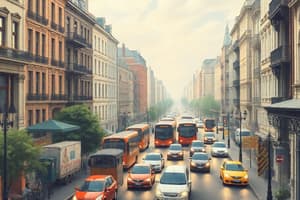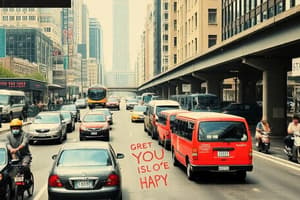Podcast
Questions and Answers
Which action would most effectively help to alleviate dense traffic in an urban area during peak hours?
Which action would most effectively help to alleviate dense traffic in an urban area during peak hours?
- Advising drivers to 'grind the gears' to increase vehicle speed and reduce congestion.
- Implementing a public transportation system to 'divert the traffic'. (correct)
- Promoting the use of 'right-hand drive cars' to streamline traffic flow.
- Encouraging drivers to 'get into reverse' more frequently to find alternative routes.
A driver is approaching a roundabout but needs to make a U-turn. Considering the provided phrases, what's the safest initial action?
A driver is approaching a roundabout but needs to make a U-turn. Considering the provided phrases, what's the safest initial action?
- Aggressively 'change gears' to quickly merge into the circulating traffic.
- 'Hail' oncoming traffic to signal the intention to make a U-turn.
- Immediately 'go sideways' into the roundabout to quickly change direction.
- Enter the roundabout and 'keep to the left', circulating until the desired exit is reached. (correct)
What does it typically mean when 'the traffic is building up' on a highway during rush hour?
What does it typically mean when 'the traffic is building up' on a highway during rush hour?
- The traffic is being 'severely disrupted' by unexpected road improvements.
- The traffic is expected to 'die down' quickly due to road maintenance.
- The traffic is becoming increasingly congested and is likely to 'tail back'. (correct)
- The traffic flow is decreasing and about to 'ease off'.
While driving a 'manual car' on a steep incline, which action demonstrates proficient vehicle control?
While driving a 'manual car' on a steep incline, which action demonstrates proficient vehicle control?
When navigating a road with 'oncoming traffic', what does it primarily require a driver to do?
When navigating a road with 'oncoming traffic', what does it primarily require a driver to do?
Flashcards
Dense traffic
Dense traffic
Heavily congested traffic, often causing delays.
Die down
Die down
To gradually decrease in intensity or volume.
Tail back
Tail back
To extend back in a long line, usually due to traffic congestion.
Valid driving license
Valid driving license
Signup and view all the flashcards
Oncoming traffic
Oncoming traffic
Signup and view all the flashcards
Study Notes
- Traffic Disruptions: Traffic can be severely disrupted.
- Traffic Diversion: Authorities may divert traffic to alternative routes.
- Dense Traffic: Indicates a high volume of vehicles on the road.
- Traffic Reduction: Traffic may die down or ease off, indicating a decrease in congestion.
- Traffic Congestion: Being stuck in traffic signifies being delayed due to congestion.
- Traffic Queue: Traffic can tail back, forming a long queue of vehicles.
- Increasing Congestion: Traffic is building up, suggesting worsening congestion.
- Driving License: A valid driving license is required to operate a vehicle legally.
- Gear Shifting: Changing gears is a fundamental aspect of driving a manual car.
- Reversing: Getting into reverse allows the vehicle to move backward.
- Grinding Gears: Grinding the gears refers to a harsh sound produced by improper gear shifting.
- Automatic vs. Manual: Cars can be either automatic or manual, referring to the transmission type.
- Direction: Bear left means to gently change direction to the left.
- Lane Discipline: Keep to the left means to stay in the left lane.
- Hailing: To hail means to salute.
- Oncoming Traffic: Vehicles approaching from the opposite direction.
- Right-Hand Drive: A right-hand drive car has the steering wheel on the right side.
- Steering Wheel: The steerable wheel allows the driver to control the direction of the vehicle.
- Handlebars: Handlebars are used for steering on bicycles and motorcycles.
- Going Sideways: To go sideways means to end badly or go crazy.
- Moving Sideways: To move sideways means to move from left to right.
Studying That Suits You
Use AI to generate personalized quizzes and flashcards to suit your learning preferences.




